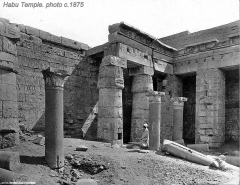carrie wrote:Third photo, can't orientate myself what are the ruins in the back ground please?
From the photograph Carrie, it was obviously taken inside Habou Temple, looking almost North. The ruins as you call them were part of the outer mud brick wall that surrounded this temple. Within the wall throughout, many dwellings were incorporated into it. In my own observations it was easy to realise these were not simply guard houses, a number of them had centre columns to support roofs, again all built within the wall.
To see the best remaining examples, come out of the temple but remain within the complex, ( in other words stay within the mud brick enclosure), now walk towards the back of the temple, you will now notice there is a once bricked-up gate way in the centre of the West facing wall, ( a sort of ancient tradesman's entrance). Climb up this area near the centre of this wall, and there, either side of the 'gateway' are what remains of the best examples.
In certain areas of the ancient perimeter mud brick wall around karnack Temple there are some brilliant examples, though I should warn you they are in an area that the authority's regard as seriously 'out of bounds' these days. They are much more well preserved than at Habou, simply for the reason that they are not exposed to that constant breeze, plus the strong winter winds from the Western Hills.
P.S.- the information attached to the photograph suggests the extent of the flood plane, that is correct. In the open air restaurant of the Marsan Hotel, there is a small gate that leads to the fields on eastern wall, before the High Dam was built, the flood plain reached to the very edge of this said gate.
















